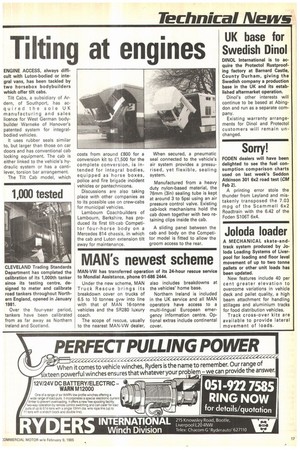Tilting at engines Swedish Dinol
Page 19

If you've noticed an error in this article please click here to report it so we can fix it.
UK base for
ENGINE ACCESS, always difficult with Luton-bodied or integral vans, has been tackled by two horsebox bodybuilders which offer tilt cabs.
Tilt Cabs, a subsidiary of Ardern, of Southport, has acquired the sole UK manufacturing and sales licence for West German bodybuilder Warneke of Hanover's patented system for integralbodied vehicles.
It uses rubber seals similar to, but larger than those on car doors and has conventional cab locking equipment. The cab is either linked to the vehicle's hydraulic system or has a cantilever, torsion bar arrangement.
The Tilt Cab model, which costs from around £800 for a conversion kit to £1,500 for the complete conversion, is intended for integral bodies, equipped as horse boxes, police and fire brigade incident vehicles or pantechnicons.
Discussions are also taking place with other companies as to its possible use on crew-cabs for municipal vehicles.
Lambourn Coachbuilders of Lambourn, Berkshire, has produced its first tilt-cab Competitor four-horse body on a Mercedes 814 chassis, in which the cab and Luton extension tilt away for maintenance. When secured, a pneumatic seal connected to the vehicle's air system provides a pressurised, yet flexible, sealing system.
Manufactured from a heavy duty nylon-based material, the 76mm i3ln) sealing tube is kept at around 3 to 5psi using an air pressure control valve. Existing cab-lock mechanisms hold the cab down together with two retaining clips inside the cab.
A sliding panel between the cab and body on the Competitor model is fitted to allow the groom access to the rear.


































































































